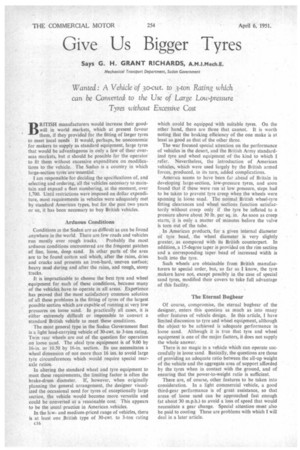Give Us Bigger Tyres
Page 54

If you've noticed an error in this article please click here to report it so we can fix it.
Says G. H. GRANT RICHARDS, A.M.I.Mech.E.
Mechanical Transport Department, Sudan Government
Wanted: A Vehicle of 30-cwt. to 3-ton Rating which can be Converted to the Use of Large Low-pressure Tyres without Excessive Cost BRITISH manufacturers would increase their goodwill in world markets, which at present favour them, if they provided for the fitting of larger tyres to meet local needs It would, perhaps, be uneconomic for makers to supply as standard equipment, large tyres that would be advantageous in only a few of their overseas markets, but it should be possible for the operator to fit them without excessive expenditure on modifications to the vehicle. The Sudan is a country in which large-section tyres are essential.
I am responsible for deciding the specifications of, and selecting and ordering, all the vehicles necessary to maintain and expand a fleet numbering, at the moment, over 1,700. Until restrictions were imposed on dollar expenditure, most requirements in vehicles were adequately met by standard American types, but for the past two years or so, it has been necessary to buy British vehicles.
Arduous Conditions
Conditions in the Sudan are as difficult as can be found anywhere in the world. There are few roads and vehicles run mostly over rough tracks. Probably the most arduous conditions encountered are the frequent patches of fine, loose, deep sand. In other parts of the area are to be found cotton soil which, after the rains, dries and cracks and presents an iron-hard, uneven surface; heavy mud during and after the rains, and rough, stony tracks.
It is impracticable to choose the best tyre and wheel _equipment for each of these conditions, because many of the vehicles have to operate in all areas. Experience has proved that the most satisfactory common solution of all these problems is the fitting of tyres of the largest possible section which are capable of running at very low pressures on loose sand. In practically all cases, it is either extremely difficult or impossible to convert a standard British vehicle to meet these conditions.
The most general type in the Sudan Government fleet is a light load-carrying vehicle of 30-cwt. to 3-ton rating. Twin rear wheels are out of the question for operation on loose sand. The ideal tyre equipment is of 9.00 by 16-in. or 10,50 by 16-in. section. Its use necessitates a wheel dimension of not more than 16 ins, to avoid large tyre circumferences which would require special rearaxle ratios.
In altering the standard wheel and tyre equipment to meet these requirements, the limiting factor is often the brake-drum diameter. If, however, when originally planning the general arrangement, the designer visualized the occasional need for tyres of exceptionally large section, the vehicle would become more versatile and could be converted at a reasonable cost. This appears to be the usual practice in American vehicles.
In the lowand medium-priced range of vehicles, there is at least one British type of 30-cwt. to 3-ton rating CI 6 which could be equipped with suitable tyres. On the other hand, there are three that cannot. It is worth noting that the braking efficiency of the one make is at least as good as that of the other three.
The war focused special attention on the performance of vehicles in the desert, and the British Army standardized tyre and wheel equipment of the kind to which I refer. Nevertheless, the introduction of American vehicles, which were used largely by the British armed forces, produced, in its turn, added complications.
America seems to have been far ahead of Britain in developing large-section, low-pressure tyres, and soon found that if these were run at low pressure, steps had to be taken to prevent tyre creep when the wheels were spinning in loose sand. The normal British wheel-tyre fitting clearances and wheel sections function satisfactorily without creep only if the tyre be inflated to a pressure above about 30 lb. per sq. in. As soon as creep starts, it is only a matter of minutes before the valve is torn out of the tube.
In American products, for a given internal diameter of tyre bead, the wheel diameter is very slightly greater, as compared with its British counterpart. In addition, a 15-degree taper is provided on the rim section and a corresponding taper bead of increased width is built into the tyre.
Such wheels are obtainable from British manufacturers to special order, but, so far as I know, the tyre makers have not, except possibly in the case of special sand tyres, modified their covers to take full advantage of this facility.
The Eternal Bugbear Of course, compromise, the eternal bugbear of the designer, enters this question as much as into many other features of vehicle design. In this article, 1 have limited discussion to tyre and wheel equipment, although the object to be achieved is adequate performance in loose sand. Although it is true that tyre and wheel equipment is one of the major factors, it does not supply the whole answer.
There is no magic in a vehicle which can operate successfully in loose sand. Basically, the questions are those of providing an adequate ratio between the all-up weight of the vehicle and the aggregate area of support afforded by the tyres when in contact with the ground, and of ensuring that the power-to-weight ratio is sufficient.
There are, of course, other features to be taken into consideration. In a light commercial vehicle, a good third-gear performance is of great assistance, so that areas of loose sand can be approached fast enough (at about 30 m.p.h.) to avoid a loss of speed that would necessitate a gear change. Special attention .must also be paid to cooling These are problems with which I will deal in a later article.




































































































